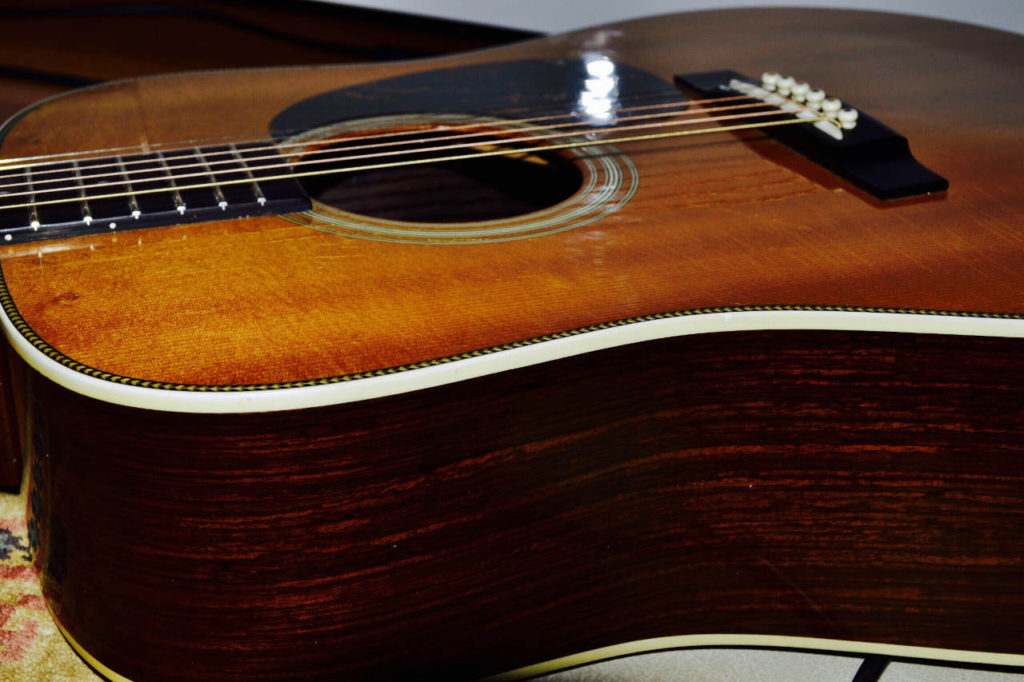Music Theory can seem like a minefield of jargon and concepts to just about everybody at one time or another, but behind it all lie the fundamentals that underpin everything. Here’s a beginner’s guide to music theory
1. There are 12 notes in western music:
1 2 3 4 5 6 7 8 9 10 11 12 1
A, A#/Bb, B, C, C#/Db, D, D#/Eb, E, F, F#/Gb, G, G#/Ab, A
Some notes have two names…..i.e. A# – called A sharp meaning the note after A is the same as Bb, called B flat or the note before B
B and E do not have have sharps after them, which means F and C don’t have flats before them.
2. The Major Scale
The major scale is the most important scale, and the best to learn music theory around. It has 7 notes and if you start on the first note above, the A, and select notes 1, 3, 4, 6, 8, 10,12 this gives you the A major Scale. There are 8 notes shown below…note 8 is the start of the next part of the scale, an octave or 12 frets up from the A in the first position
I II III IV V VI VII VIII
A B C# D E F# G# A
Roman numerals denote the position of the notes in the scale. In any major scale there is a gap of 2 notes (equal to one tone or 2 frets) between notes 1 and 2, One tone between notes 2 and 3, a half tone (1 note or 1 fret) between notes 3 and 4. One tone between 4 and 5, 5and 6, and 6and 7 , and a half tone between notes 7 and 8.
Main keys and notes of major scales:
I II III IV V VI VII VIII
A A B C# D E F# G# A
C C D E F G A B C
D D E F# G A B C# D
E E F# G# A B C # D# E
G A B C C D E F# G
3. Chords
Three notes form a chord..these three notes are also called a triad. To form a major chord, you take notes 1, 3 and 5…so to form an A major chord take notes 1,3 and 5 of the A major scale, which are A, C# and E, and to form a C major chord, take notes 1, 3 and 5 of the C major scale (C, E and G). The notes making up the main major chords are shown below
Notes of Major chords
I III V
A A C# E
D D F# A
E E C# B
C C E G
G G C D
Minor chords can be formed the same by taking notes 1,3 and 5 of the respective minor scale. Minor chords are only one note different from major chords, and the difference is in the note known as the 3rd (the second note along in the table above…the C# in the A chord). To make a minor chord you flatten this note by a semi tone….in other words you play the note before it on your guitar, so in an A chord, instead of playing a C# note you would play a C, and in a C chord, instead of playing an E note, you would play an Eb.
Notes of minor chords:
I III V
Am A C E
Dm D F A
Em E G B
Gm G Bb D
Cm C Eb G
4. Chord Scales
So how do the major and minor chords interact. I think the single most useful bit of music theory is playing a scale as chords instead of single notes. There are a few uses for this….one is it gives you a fair idea of the chords you may expect to see in a song which helps a lot with learning new songs, and it also gives an idea of chords which sound good together…very useful if your writing a song.
Here is the C major scale played as chords:
I II III IV V VI VII VIII
C Cmajor Dminor Emin Fmaj Gmaj Amin Bdiminished C
So, the first note of any major scale gives a major chord, 2nd note a minor chord, 3rd minor, 4th major, 5th major, 6th minor and 7th note a diminished chord.
Some of these chords are used in songs more than other, with the backbone of a LOT of songs being the I IV V chords, which in the key of C are C, F and G. The next most used chord is the VI chord, which in the key of C is an Am. The VI chord and the I chord are closely linked and the VI chord is known as the relative minor of the I chord, so in this case, Am is the relative minor of C.
Main chords:
I IV V VI
C C F G Am
D D G A Bm
E E A B C#m
G G C D Em
A A D E F#m
The classic I, IV, V progression underpins the 12 bar blues, as well as most country, folk and rock and roll songs, while a huge percentage of all songs are driven along by the chords above. There are many other progression that work well together, and I’ll deal with other progressions and more theory in another post. The key thing when playing is don’t be afraid to experiment with other chords, and the main rule is that if it sounds right, it is right.
